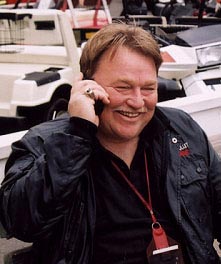
1320 Vision:
I know you readers will find this hard to believe, but recently I had an unpleasant little run-in with the "suits" currently in charge at NHRA. They handled the problem we had with all the delicacy of a Hulk Hogan body slam. As a result, I've been thinking about that nearly 54-year-old sanctioning body for the past couple of days and I've come to some conclusions that I would like to share with you. The first and perhaps the most important realization I came to is that the NHRA of today represents in no way, shape, or form the sanctioning body that Wally Parks (Editor of Hot Rod Magazine at the time) was instrumental in starting for the benefit of car clubs back in 1951. Those drag racing icons incorporated the NHRA as a tax exempt, not for profit Corporation under the federal guidelines for a 501(C) organization. Here is the IRS legal definition of a 501(C) Corporation (also known as a business league): "A business league is an association of persons having some common business interest, the purpose of which is to promote such common interest and not to engage in a regular business of a kind ordinarily carried on for profit. Trade associations and professional associations are business leagues. To be an exempt, a business league's activities must be devoted to improving business conditions of one or more lines of business as distinguished from performing particular services for individual persons. No part of a business league's net earnings may inure to the benefit of any private shareholder or individual and it may not be organized for profit to engage in an activity ordinarily carried on for profit (even if the business is operated on a cooperative basis or produces only enough income to be self-sustaining). The term 'line of business' generally refers either to an entire industry or to all components of an industry within a geographic area. It does not include a group composed of businesses that market a particular brand within an industry." To an outsider, the current NHRA wouldn't seem at least in spirit to meet the above guidelines. In a profile story that DRO contributor Dave Wallace did for Petersen Publication's History of Drag Racing, Wally Parks explained what his intentions were: "NHRA was formed as a semi-social car club organization; racing was not its aim or ambition." In 1953 the NHRA turned away from that "semi-social car club" theme and changed forever when it held the first race at the Pomona Fairgrounds and 15,000 fans (according to Mr. Parks) paid a half buck each to watch drag racing. Wally Parks and everyone else at that race realized right then that people would pay to watch drag racing. For the next forty years or so, in my opinion, the NHRA gradually but relentlessly drifted away from Mr. Parks' original vision for it and slowly morphed into an entertainment business dedicated primarily to making money. Over the years the NHRA supported a relatively large "family" of employees, but, thanks to the number of ex-racers who worked at all levels of NHRA management from the president to members of the track crews, the NHRA enjoyed a unique relevancy and kinship with its members and racers. The members and racers believed then, and many still do, that NHRA is the semi-social club it started out to be. I believe that it really became a defacto "for profit" company when Dallas Gardner became the president of the NHRA and approached the job like any traditional corporate executive would. Under his stewardship the NHRA grew. It acquired tracks, improved the venues and attracted Corporate America in numbers never seen previously. But, according to my sources and the NHRA 2002 tax returns, his actions led to a substantial debt load for the company. At some point the board of directors concluded in typical corporate fashion that new leadership was required the right the ship so they eased Gardner out and promoted Tom Compton to the presidency and, I suspect, tasked him primarily with reducing the NHRA's debt load and increasing profits. They evidently wanted a corporate executive that could turn NHRA's fortunes around, and Compton was that guy. Dallas Gardner became the Chairman of the Board with a very good salary, but Compton became the person firmly in control of the NHRA. Compton began his reign at the top by almost immediately purging the NHRA management team of racer-friendly executives such as Steve Gibbs, Carl Olson and Neil Britt. He staffed his management team with friends and who would be loyal to him and share his vision. Unfortunately, his new inner circle had little if any personal experience or history with drag racing. All of his team, with the exception of Len Imbrogno, Graham Light and Cary Menard, came from Corporate America. One of the first things the new team did was rid the company of approximately 20 employees using the excuse that the company was in financial trouble. Since that time Compton's management team has overseen the steady reduction of the work force and budget at all levels of the NHRA including the reduction or elimination of "perks" taken for granted by employees for many years. At the same time the management team has done everything possible to maximize every possible profit center and department. As a result the NHRA revenues increased from approximately $96,500,000 in 2002 to just under $100,000,000 in 2003. Compton and his team have done what they were hired to do. There are no "old school" ties to drag racing for most of his management team so they had no problem implementing changes that alienated racers, companies, or old friends. Their job is to make NHRA more profitable and evidently they don't care who they piss off or on to get that job done. The second realization I have come to about the current NHRA is that the men in charge are professional executives. They are trained to manage and promote companies and their products and it makes little difference to them what that company's product or history is. For them it doesn't matter if the company is involved in the promotion or sales of dog food, hockey pucks or auto racing; it's all the same to most of them. NHRA is a tax exempt, not-for-profit Corporation according to the letter of the law, but for those working for and racing with that organization it is strictly a business. I believe there was a time when it didn't matter what part of the NHRA generated money; it was used to support all of NHRA's programs. If the money generated by the Pros had to be used to support the Sportsman programs, it wasn't a big deal. But not any more, my fellow racers and NHRA members. In the new, more corporate NHRA, the head of every department and division had better show a profit at the end of the year or be ready to explain why he or she didn't. And that includes the racetracks that NHRA owns, the National Dragster, Main Gate (trash and treasure sold at Nitro Mall, Wal-Mart, etc.) and the events themselves. I'm told that only two of the seven Sportsman divisions currently don't cost the company money to run and that in the coming season and years the Sportsman program will have to at least support itself or it will be reworked until it does. Nothing stays the same. The NHRA of today is nothing like what it began as over 50 years ago when the people in charge were hot rodders first and then businessmen instead of being businessmen exclusively. While the revenue streams for the NHRA have increased significantly, the sense of connection and camaraderie that used to flow between the members, racers, fans, and press and the NHRA management appears to have all but disappeared. Perhaps I'm just clinging to the past here, maybe I don't see the "big picture" or maybe I just don't understand the business of drag racing, but I can tell you this much. What I can see isn't very attractive and I don't know why people join NHRA other than for the National Dragster and the additional insurance coverage should you get injured while attending a race. I don't believe the NHRA today is what Wally Parks had in mind when he started the organization back in 1951. Then again, Mr. Parks and Dallas Gardner were responsible for bringing in the current management team and thus responsible for what NHRA has become in 2004 where the bottom line is more important than the finish line.
|
|||||||||||||||||||||||||||||||||||||||||||||||||




